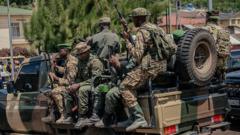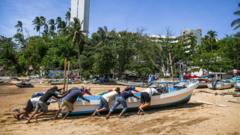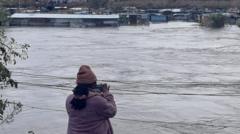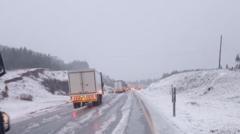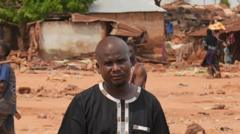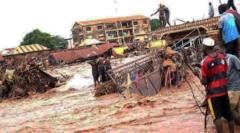At least 33 lives have been lost due to the relentless rains that struck Kinshasa, the bustling capital of the Democratic Republic of Congo, as officials report widespread flooding and chaos in the region.
Dozens Dead as Severe Floods Devastate Kinshasa

Dozens Dead as Severe Floods Devastate Kinshasa
Torrential rains claim lives and flood homes in the Congolese capital, leaving residents desperate for safety.
The heavy rainfall prompted local residents to seek refuge from the rising waters, with many resorting to wading through murky streets or navigating makeshift canoes to escape their submerged neighborhoods. The city, which houses around 17 million people and borders the Congo River—one of the largest rivers globally—has long been impacted by seasonal flooding, but this year's deluge has hit with unprecedented force, with the river reaching its highest levels in nearly 60 years.
The mayor of Kinshasa disclosed that approximately half of the 26 districts have been adversely impacted, with the poorest outskirts suffering the greatest devastation. Homes were demolished overnight, particularly in areas like Ndanu, where residents like Christophe Bola recounted harrowing experiences of survival above rising waters that reached 1.5 meters high.
Frustration is mounting among the inhabitants, who have criticized the slow response from local authorities. Reports indicate that the flooding has left a significant portion of Kinshasa dealing with acute water shortages, exacerbated by inundated water treatment facilities. Major routes, including the primary connecting road between the city's center and the international airport, have become impassable, further stranding citizens.
According to statements from Deputy President Jacquemain Shabani, the N'djili River, already recognized as one of the region's most polluted waterways, has overflowed, trapping numerous families within its boundaries. Over recent years, inadequate sewage maintenance and poor town planning have worsened the city's vulnerability to such disasters. The government had previously unveiled plans to address these longstanding infrastructural issues, but the latest calamity highlights the urgent need for action.
With forecasts indicating more heavy rainfall in the coming days for northern and northeastern regions of DR Congo, authorities and citizens alike brace for potential further distress amid the growing climate crisis.
The mayor of Kinshasa disclosed that approximately half of the 26 districts have been adversely impacted, with the poorest outskirts suffering the greatest devastation. Homes were demolished overnight, particularly in areas like Ndanu, where residents like Christophe Bola recounted harrowing experiences of survival above rising waters that reached 1.5 meters high.
Frustration is mounting among the inhabitants, who have criticized the slow response from local authorities. Reports indicate that the flooding has left a significant portion of Kinshasa dealing with acute water shortages, exacerbated by inundated water treatment facilities. Major routes, including the primary connecting road between the city's center and the international airport, have become impassable, further stranding citizens.
According to statements from Deputy President Jacquemain Shabani, the N'djili River, already recognized as one of the region's most polluted waterways, has overflowed, trapping numerous families within its boundaries. Over recent years, inadequate sewage maintenance and poor town planning have worsened the city's vulnerability to such disasters. The government had previously unveiled plans to address these longstanding infrastructural issues, but the latest calamity highlights the urgent need for action.
With forecasts indicating more heavy rainfall in the coming days for northern and northeastern regions of DR Congo, authorities and citizens alike brace for potential further distress amid the growing climate crisis.


